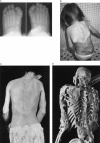Fibrodysplasia ossificans progressiva, a heritable disorder of severe heterotopic ossification, maps to human chromosome 4q27-31
- PMID: 10631143
- PMCID: PMC1288317
- DOI: 10.1086/302724
Fibrodysplasia ossificans progressiva, a heritable disorder of severe heterotopic ossification, maps to human chromosome 4q27-31
Abstract
Fibrodysplasia ossificans progressiva (FOP) is a severely disabling, autosomal-dominant disorder of connective tissue and is characterized by postnatal progressive heterotopic ossification of muscle, tendon, ligament, and fascia and by congenital malformation of the great toes. To identify the chromosomal location of the FOP gene, we conducted a genomewide linkage analysis, using four affected families with a total of 14 informative meioses. Male-to-male transmission of the FOP phenotype excluded X-linked inheritance. Highly polymorphic microsatellite markers covering all human autosomes were amplified by use of PCR. The FOP phenotype is linked to markers located in the 4q27-31 region (LOD score 3.10 at recombination fraction 0). Crossover events localize the putative FOP gene within a 36-cM interval bordered proximally by D4S1625 and distally by D4S2417. This interval contains at least one gene involved in the bone morphogenetic protein-signaling pathway.
Figures




References
Electronic-Database Information
-
- GeneMap 1999, http://www.ncbi.nlm.nih.gov/genemap/ (for localization of genes and expressed-sequence tags)
-
- Online Mendelian Inheritance in Man (OMIM), http://www.ncbi.nlm.nih.gov/Omim (for FOP [MIM 135100]) - PubMed
-
- Radiation Hybrid Mapping, http://carbon.mit.edu:8000/cgi-bin/contig/rhmapper.pl (for radiation-hybrid mapping)
-
- Research Genetics, Huntsville AL, http://www.resgen.com (for linkage analysis)
References
-
- Bi W, Deng JM, Zhang Z, Behringer RR, De Crombrugghe B (1999) Sox9 is required for cartilage formation. Nat Genet 22:85–89 - PubMed
-
- Cohen RB, Hahn GV, Tabas JA, Peeper J, Levitz CL, Sando A, Sando N, et al (1993) The natural history of heterotopic ossification in patients who have fibrodysplasia ossificans progressiva. A study of forty-four patients. J Bone Joint Surg Am 75:215–219 - PubMed
-
- Connor JM, Evans DAP (1982a) Fibrodysplasia ossificans progressiva: the clinical features and natural history of 34 patients. J Bone Joint Surg Br 64:76–83 - PubMed
Publication types
MeSH terms
Grants and funding
LinkOut - more resources
Full Text Sources
Other Literature Sources

